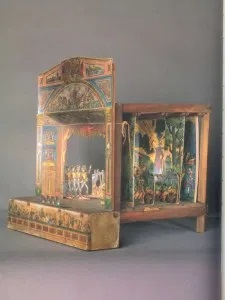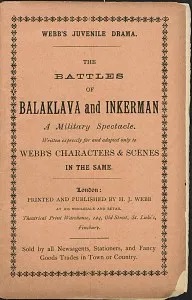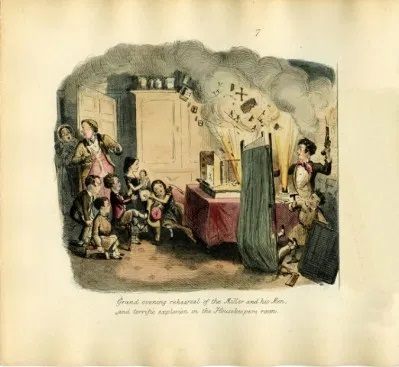Toy Theaters and Child’s Play

Front for a Toy Theater Stage, image courtesy of the Downs Collection, Winterthur Library.
Master Jacky receives and paints the toy theater set. Courtesy of Winterthur Library.
Master Jacky receives and paints the toy theater set. Courtesy of Winterthur Library.

Toy theater set, showing the construction of the stage and front. Image courtesy of the Canadian Adaptions of Shakespeare Project.
Toy theaters required a certain degree of manual and mental ingenuity. The 1866 edition of The Boy’s Own Treasury of Sports and Pastimes, published simultaneously in London and New York, included detailed instructions for the assembly of a toy theater: the scenes and characters were of course purchased, as could a kit for the stage. The authors encouraged truly industrious lads, however, to earn the praise of their elders and companions by building their own stage, as its simple form was “not unlike a four-post bedstead.” The benefits of mechanical skill were thus viewed not just in terms of the child’s personal development but social development as well.
The performance itself required exceptional organizational abilities, particularly for a younger child. The production’s director (or “lead boy”) decided who managed the characters, changed the scenery, read the script, and provided any necessary sound effects or musical accompaniment. This required a significant degree of rehearsal and discipline and thus—at least in theory—increased the age range of boys who would enjoy using the set. Webb’s own instructions implied that a “stage crew” would have been needed to properly staff the production, as the reader was supposed to be on-stage, always facing the audience—usually a small assembly of family members in the parlor. At least one other person would have been needed to move the characters on and off the stage during the production—ideally two, one for each side of the stage.
The reality seems to be that painting the characters and constructing the set was the favorite part of children in the era. Robert Louis Stevenson, a toy theater enthusiast in his youth, stated: “when all was painted, it is needless to deny it, all was spoiled… to cut the figures out was simply sacrilege; nor could any child twice court the tedium, the worry, and the long-drawn disenchantment of an actual performance.”
A deeper, less understood role was how the toy theater sets mimicked the adult world surrounding the children. Everything present in the set would have had its full-sized counterpart in an adult theater. Often, the plays produced by toy theater companies would have been pared-down versions of the adult productions. The H.J. Webb company, for example, adapted popular melodramas such as The Miller and His Men, pantomimes such as Alladin, and even novels and other literature, in particular Harriet Beecher Stowe’s Uncle Tom’s Cabin and Shakespeare’s history plays. These scripts were “written expressly for and adapted only to” the figures and backgrounds published by Webb’s and available in the kit.

Script Book for Webb’s “The Battles of Balaclava and Inkerman: A Military Spectacle.” Image courtesy of Downs Collection, Winterthur Library.
During the Crimean War, however, toy theater publishers, including Webb’s, began adapting accounts of military engagements within weeks of the news reaching England. This verged into uncharted territory and was met with mixed public reaction. Webb’s set for The Battles of Balaklava and Inkerman takes a “safe” stance on the issues by not depicting British casualties but hints at the disastrous consequences of commander error in the charge of the Light Brigade at the Battle of Balaklava. Its ambiguous ending at the Battle of Inkerman, which also included heavy loss of life due to error, encourages some speculation as to the final opinion of the publishers, and may have cued youngsters in to some of the public outrage of the adult world. The Crimean War was one of the first to be reported to the general public through the channels of war correspondents—particularly William Howard Russell of the London Times. For the first time, the lack of direct government censorship meant that the public was aware of the conditions faced by the soldiers and the consequences of ill-advised executive decisions and the poor organization of humanitarian necessities such as hospitals for the wounded. A military-themed toy theater set, after this news broke, would not have seemed so light-hearted, or even appropriate for younger children.
Toy theaters remained a popular pastime, increasingly so in America, through the beginning of the twentieth century. As Victorian theories of childhood and child-rearing gained wider hold, the subject matter veered away from boy-centered development and adapted productions of the adult world to travel, fairy tales, and fashion plates… suitable for both boys and girls. Indeed, some the scripts became more optional, and children were encouraged to use their imagination to recreate the story. The story of the toy theater is just as much a story of the development of perceptions and expectations of childhood in England and America.

A production for “Cinderella” from “The Delineator,” 1918. Image courtesy of the Downs Collection, Winterthur Library.
About The Decorative Arts Trust Bulletin
Formerly known as the "blog,” the Bulletin features new research and scholarship, travelogues, book reviews, and museum and gallery exhibitions. The Bulletin complements The Magazine of the Decorative Arts Trust, our biannual members publication.









